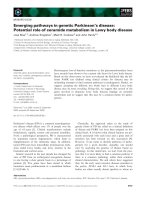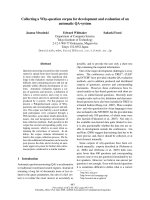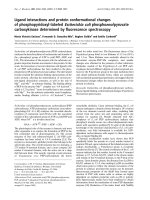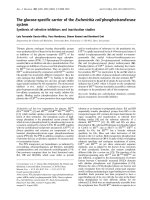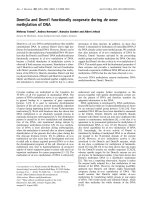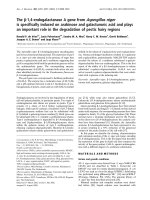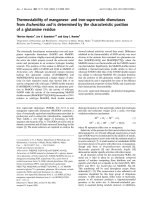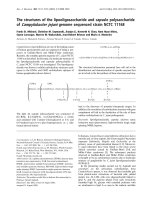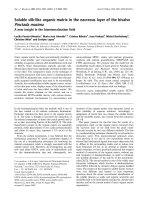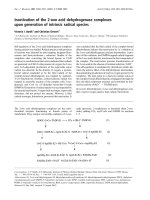Tài liệu Báo cáo Y học: Interallelic complementation provides genetic evidence for the multimeric organization of the Phycomyces blakesleeanus phytoene dehydrogenase doc
Bạn đang xem bản rút gọn của tài liệu. Xem và tải ngay bản đầy đủ của tài liệu tại đây (218.35 KB, 7 trang )
Interallelic complementation provides genetic evidence
for the multimeric organization of the
Phycomyces blakesleeanus
phytoene dehydrogenase
Catalina Sanz
1
, Marõ
Â
a I. Alvarez
1
, Margarita Orejas
1,
*, Antonio Velayos
1
, Arturo P. Eslava
2
and Ernesto P. Benito
2
1
Area de Gene
Â
tica, Departamento de Microbiologõ
Â
a y Gene
Â
tica, Universidad de Salamanca, Edi®cio Departamental, Avda, Salamanca,
Spain;
2
Centro Hispano-Luso de Investigaciones Agrarias, Universidad de Salamanca, Edi®ci o Departamental, Avda, Salamanca,
Spain
The Phycomyces blakesleeanus wild-type is yellow, because it
accumulates b-carotene a s t he main carotenoid. A new
carotenoid mutant of this f ungus (A486) was isolated, a fter
treatment w ith ethyl methane sulfonate (EMS), showing a
whitish coloration. It accumulates large amounts of phyto-
ene, small quantities of phyto¯uene, f-carotene and neuro-
sporene, in decreasing amounts, and traces of b-carotene.
This phenotype i n dicates that it carries a leaky mutation
aecting t he enzyme phytoene dehydrogenase (EC 1.3 ),
which i s s peci®ed by the gene carB. B iochemical analysis of
heterokaryons showed that mutant A486 complements t wo
previously characterized carB mutants, C5 (carB10)and
S442 (carB401). Sequence analysis of the carB gene genomic
copy from these three strains revealed that they are all altered
in the gene carB, giving infor mation about the nature o f the
mutation in each carB mutant allele. The interallelic com-
plementation provides evidence for the multimeric organi-
zation of the P. blakesleeanus phytoene dehydrogenase.
Keywords: carotenoid; phytoene dehydrogenase; i nterallelic
complementation; Phycomyc es blakesleeanus .
Carotenoids represent one of the most abundant and widely
distributed classes of pigment in nature. They are present in
photosynthetic bacteria, c yanobacteria, algae and higher
plants as well as in nonphotosynthetic bacteria and fungi [1].
Carotenoids are colour pigments in ¯owers and fruits and
also in many cr ustaceans, insects, ®shes a nd birds [ 2]. T hey
play essential roles in photosynthesis [3], photooxidative
protection [4], nutrition, vision and cellular differentiation
[5]. Some c arotenoids are u sed in the cosmetic and f ood
industries and their potential use in disease prevention in
humans and as antitumor agents is being con sidered [6,7].
Nowadays, there is considerable interest in the manipula-
tion of carotenoid content a nd composi tion i n plants to
improve t he agronomical and nutritional value for human
and animal consumption [8].
Among fungi, b-carotene and neurosporaxanthin are
the main carotenoids accumulated in the ascomycetes
Gibberella fujikuroi and Neurospora crassa; astaxanthin p re-
dominates in the basidiomycete yeast Xanthophyllomyces
dendrorhous, and b-carotene is the main carotenoid i n the
Mucorales Blakeslea trispora, Mucor circinelloides and
P. blakesleeanus [9,10]. M utants altered in the carotenoid
pathway are detected by a change in colour due to the
accumulation or lack of intermediate products or to
overproduction of the end product. In Mucorales, many
early studies on carotenoids biosynthesis were performed
in P. blakesleeanus (reviewed i n [11]) but recently caro-
tenoid m utants of M. circinelloides have been isolated and
investigated [12±15], because the lack of an ef®cient
transformation system in Phycomyces impedes the isola-
tion of genes by direct complementation and their
functional analysis [16].
In fungi, the speci®c carotenoid pathway to b-carot ene
proceeds via three enzymatic steps carried out by the
enzymes phytoene synthase, phytoene dehydrogenase and
lycopene cyclase. The enzyme phytoene dehydrogenase is
able to introduce four dehydrogenations in a s ubstrate
molecule to produce lycopene. Its coding gene is named
carB in Phycomyces [17] and Mucor [18] and al-1 in
Neurospora [19]. A single bifunctional protein carries out
phytoene s ynthase a nd lycopene cyclase a ctivities i n f ungi.
The existence of a bifunctional gene was proposed by
Torres-Martõ
Â
nez et al. in 1980 for Phycomyces [20] and
recently it has been shown t o be a feature unique to fungal
carotenogenesis. So far, the crtYB gene of X. dendrorhous
[21], carRP of M. circinelloides [22] and carRA of
P. blak esleeanus [23] have been the m ost extensively studied.
The al-2 gene of N. crassa, initially identi®ed only as the
phytoene synthase c oding gene in this fungus [24], a lso
shows this characteristic (quoted in [23]). The genes carB
and ca rRP in M. circinelloides are 446 nucleotides apart and
show a c o-ordinated regulation o f their expression by blue
light, suggesting a bi-directional mode of transcriptional
control [22]. I n P. blakesleeanus, the genes carB and carRA
also show a co-ordinated regulation by light (C. Sanz &
Correspondence to A. P. Eslava, Centro Hispano-Luso de Investigac-
iones Agrarias, Universidad de Salamanca. Edi®cio Departamental,
Avda. Campo Charro s/n. E-37007, Salamanca, Spain.
Fax: + 3 4 23 294 663, Tel. + 34 23 294790, E-mail: eslav
Abbreviation: ethyl, methane sulfonate (EMS).
*Present address: Instituto de Agro quõ
Â
mica y Tecnologõ
Â
ade
Alimentos, CSIC, Valencia, Spain.
(Received 9 August 2001, re vised 30 N ovember 2 001, accepted 4
December 2001)
Eur. J. Biochem. 269, 902±908 (2002) Ó FEBS 2002
M. I. Alvarez unpublished results) although the distance
between the two genes is 1381 nucleotides [23].
In Mucorales, mutants a ltered in the gene carB are white
and accumulate phytoene [15,25]. Another group of carB
mutants (those which are leaky) are green ish, whitish or
yellowish because they accumulate partially deh ydrogen-
ated products of phytoene [26±28]. Mutants altered in t he
P or A domains of the genes carRP or carRA of Mucor and
Phycomyces, respectively, are white, accumulate no caro-
tenoid or only traces of b-carotene, and are altered in t he
enzyme phytoene synthase [15,22,29]. In Phycomyces,white
carB mutants and white carA mutants are e asily distin-
guishable, because the latter are s ensitive to vitamin A,
which in this c ase restores function, i.e. carotene synthesis
causing yellow c olour [30]. M utants disrupted in the R
domain of both the carRP and the carRA genes are red,
accumulate lycopene and are altered i n the enzyme
lycopene cyclase [15,22,25,31]. A third group of mutants
altered in t his bifunctional gene has been described for both
Zygomycetes. In Phycomyces they complement neither the
carR nor the carA mutants, and i n Mucor they complement
neither the carP nor the carR mutants. They are white, l ack
all carotenoids and have been considered mutants carrying
mutations with de®ciencies in both enzymatic activities
[15,20,22,23,31].
In Phycomyces there are several types of mutants altered
in the regulation o f t he carotenoid pathway. The carC
mutants are whitis h, because they produce only very small
amounts o f b-carotene [32]. Mutants disrupted in the genes
carS, carD and carF are deep-yellow, because they over-
produce b-carotene [33±35]. In M. circinelloides b-carotene
overproducing strains have been found [29], but the
regulation of the carotenoid pathway in Mucor seems to
be different from that in Phycomyces [12,13].
The fungus Phycomyces remains m ultinucleate through-
out the cell cycle. The mycelia are large coenocytes
containing millions of nuclei and the asexual spores are
multinucleate cells containing several nuclei, three to four
being the most frequent number of nuclei per spore. T hese
spores are formed by the division of a large mass of
cytoplasm into multinucleate portions that develop strong
cell walls in the sporangium. This p ackaging of nuclei into
spores is random [36].
Quantitative complementat ion analysis h as led t o the
hypothesis that t he enzymes i nvolved i n the conversion of
phytoene to b-carotene in P. blakesleeanus are organized
as an enzyme aggregate [37,38]. This complex would
consist of four copies of the enzyme phytoene dehydro-
genase, which act sequentially on a molecule of phytoene,
converting it successively in phyto¯uene, f-ca rotene,
neurosporene and lycopene, and two copies of the enzyme
lycopene cyclase, which covert ®rst lycopene into
c-carotene and then c-carotene into b-carotene. So far,
no molecular evidence for such an enzymatic aggregate
has been reported.
Among the P. blakesleea nus carB mutants previously
isolated, two strains have been investigated in relation to the
effects of the induced mutation on the activity of the
enzyme: strain C5, which produces white mycelium and
only accumulates high a mounts of phytoene [25], a nd strain
S442, producing a greenish mycelium and accumulating
high amounts of phytoene and small amounts of phyto-
¯uene, f-carotene and neurosporene [28]. In vitro charac-
terization of the phytoene desaturation reaction in these two
strains revealed that the phenotypic block could be over-
come by the addition of Tween 4 0 in strain C5, but n ot in
strain S442. These observations indicated that while the
catalytic activity of the phytoene dehydrogenase in strain
S442 is directly affected by the mutation, strain C5 possesses
a f unctional enzyme, likely altered in a region relevant for
the correct spatial organization of the enzyme or of the
enzyme complex [39].
In this paper, we report on the isolation and charac-
terization of a new P. blakesleeanus carB mutant strain
that shows interallelic complementation with two Phyco-
myces strains c arrying different carB alleles. This provides
genetic evidences for the multimeric o rganization of the
enzyme phytoene d ehydrogenase in Phycomyces.The
nature of the mutations in the c omplementing carB alleles
is presented.
EXPERIMENTAL PROCEDURES
Strains and growth conditions
The P. blakesleeanus strains used in this work are listed in
Table 1 . Growth media (SIV and SIVYC, minimal and rich
medium, r espectively) and g rowth conditions have been
described previously [40±42]. For colonial growth, the pH of
the media was lowered to 3.3. Minimal m edium was
supplemented as required with vitamin A (200 lgámL
)1
).
Escherichia coli strain DH5a was used for all cloning
experiments and propagation of plasmids. It was grown
under previously described conditions [43].
Table 1. P. blakesleeanus strains used i n this work.
Strain
a
Genotype
b
Origin
c
Phenotype
d
NRRL1555 (±) Standard wild-type Yellow (b-carotene)
C2 carA5 (±) NRRL1555 by MNNG mutagenesis White (traces of b-carotene)
C6 carRA12 (±) NRRL1555 by MNNG mutagenesis White (traces of lycopene)
A98 carC652 (±) NRRL1555 by NQO mutagenesis White (traces of b-carotene)
C5 carB10, geo10 (±) NRRL1555 by MNNG mutagenesis White (phytoene)
S442 carB401, mad107, carS42 (±) C115 (carS42, mad 107 (±))by MNNG mutagenesis Greenish (phytoene)
A486 carB679 (±) NRRL1555 by EMS mutagenesis Whitish (phytoene)
a
Pre®xes A, C, and S refer to strains isolated at the University of Salamanca, The California Institute of Technology and the University of
Sevilla, respectively.
b
car indicates a mutant with abnormal carotene production; mad indicates a mutant with abnormal phototropism; geo
indicates a mutant with abnormal geotropism; (+) and (±) indicate the two mating types.
c
MNNG, N-methyl-N¢-nitro-N-nitrosoguanidine;
NQO, 4-nitroquinoline-1-oxide; EMS, ethyl methane sulfonate.
d
Colour of mycelium and main carotenoid accumulated.
Ó FEBS 2002 Interallelic complementation in Phycomyces (Eur. J. Biochem. 269) 903
Mutagenesis and isolation of mutants
Vegetative spores of P. blakesleeanus strain NRRL1555
were treat ed w ith ethyl methane sulfonate ( EMS) (3%, v/v)
in phosphate buffer (0.1
M
,pH7.0)at22°C during 4 .5 h.
The chemical was washed off with d istilled water. Aliquots
of the t reated spores (5 ´ 10
3
, viability about 3%) in
distilled water were spread on SIVYC plates. Germinated
spores were allowed to complete a full vegetative cycle and
harvested as i ndependent recycled spore pools. Aliquots
from each pool were plated on acidi®ed SIV medium plates.
Strain A486 was identi®ed by visual inspection of colonies
derived from the mutagenic treatment and puri®ed from a
single spore.
Carotenoid analyses
Spores from the different P. blakesleeanus strains a nd from
heterokaryons were plated on SIV plates and incubated
during three days under continuous light at 22 °C. Mycelia
were then scrapped off. A portion was used to determine the
dry weight (1 h at 105 °C) and the rest was blended in a
Sorvall Omni-Mixer with 20 mL methanol and 20 m L
petroleum ether (boiling point 50±70 °C) for 3 min. The
operation was repeated twice after c hanging the petroleum
ether and the resulting fractions were combined. Spectro-
photometric analysis o f c arotenoids in supernatant was
performed i n a Hitachi U-2000 spectrophotometer. For
quanti®cation of carotenoids, supernatant w as concentrated
in a rotoevaporator and chromatographed in alumina
column [44].
For HPLC analysis, an aliquot of the supernatant was
desiccated under nitrogen pressure and resuspended in
petroleum ether/diethyl ether (9 : 1, v/v). Carotenoids were
identi®ed and quanti®ed as previously described [22].
Phytoene, f-carotene and b-carotene were quanti®ed after
calibration making use of authentic standards.
Complementation analyses
Complementation analyses w ere performed by constructing
heterokaryons fo llowing the p rocedures described previ-
ously [45], for surgical grafting of spo rangiophores. I n e ach
case, heterokaryotic sporangia were identi®ed by plating
spores in acidi®ed SIVYC medium. Only sporangia giving
rise to different t ypes of colonies were selected for further
characterization.
Recombinant DNA procedures
Genomic DNA from P. blakesleeanus strains w as isolated
following the methods described by M o
È
ller et al.[46].
PCR ampli®cations of the genomic copies of the mutant
carB alleles were carried out in a PerkinElmer 9700
Thermal C ycler. Two oligonucleotides were designed to
amplify a genomic DNA fragment containing the entire
coding region of the gene, ¯anked by 1302 bp and
352 bp a t the 5¢ and 3¢ no ncoding regions, r espectively.
Their sequences are: oligonucleotide A, 5¢-AGTACAAA
AGACAAGACT-3¢ (nucleotide positions )1302 to )1285;
and o ligonucleoti de B,5¢-GAGTCTGAGGTGCTGTAC-3¢
(complementary to nucleotide positions +2287 to +2270)
(numbering according to the sequence reported previously
[17], accession no. X78434). PCR ampli®cations were
performed in 50 lL ®n al volume r eactions containing
10 m
M
Tris/HCl pH 8.3, 50 m
M
KCl, 1.5 m
M
MgCl
2
,
0.2 m
M
each dNTP, 0.2 l
M
each oligonucleotide, 20 ng of
genomic DNA and 2 .5 U of AmpliTaq Polymerase
(Applied Biosystems). Reaction mixtures were subjected to
one cycle at 95 °C for 2 m in; 40 cycles at 95 °Cfor30s,
60 °C for 60 s and 72 °C for 90 s ; and a ®nal additional
extension period at 72 °C for 5 m in. Ampli®ed DNA
fragments were p uri®ed from gels using the GeneClean Kit
(Bio101) and cloned i nto pGEM-T-easy vector (Promega).
Ligations, transformations of E. co li and plasmid ampli®-
cations were performed following standard procedures [43].
DNA sequencing was performed in an ABI 373 A auto-
mated DNA sequencer (Applied Biosystems).
Computer analysis
Nucleotide and amino-acid sequences were analysed u sing
the Vector NTI Suite software package (InforMax, Inc.).
Access to the PROSITE database of protein families and
domains was carried out through the utilities offered by the
ExPASy Molecular Biology server ().
RESULTS
Isolation and biochemical characterization
of a new
car
- strain
Several colour mutant str ains were obtained after EMS
treatment of P. blakesleeanus strain NRRL1555 spores.
One of these strains, A486, showed a characteristic whitish
coloration. As mostly clean white mutants, altered either in
the carB gene, in the carRA gene or in the carC ge ne, had
been previously isolated, such a phenotype p rompted us to
characterize biochemically this mutant strain.
Figure 1 shows the HPLC elution pro®les of the
carotenoids accumulated by this strain when cultured in
solid medium under continuous light conditions. For
comparison, the e lution pro®les of the carotenoids accumu-
lated by strain NRRL1555 have been included. Their
analysis showed that b-carotene i s t he main carotenoid
accumulated b y str ain NRRL1 555. S mall a mounts of
phytoene are also detected, while the three intermediates
resulting from its se quential dehydrogenation, phyto¯uene,
f-carotene and neurosporene, are h ardly detectable. Strain
A486 accumulated phytoene, phyto¯uene, f-carotene, neu-
rosporene and b-carotene. Quanti®cation o f t hese prod ucts
performed by spectrophotometric analysis and (when s tan-
dards w ere ava ilable) by HPLC analysis (Table 2) showed
that b-carotene represents about 90% of the total carote-
noids accumulat ed by s train NRRL1555, and phytoene
about 8%. Phyto¯uene, f-carotene and neurosporene, all
together, r epresent less t han 2%. Strain A486 accumulates
mainly large quantities of phytoene, indicating that it is
altered in the dehydrogenation of phytoene, probably in the
carB gene, so far the only gene involved in this metabolic step
reported in P. blakesleeanus. Small and decreasing amounts
of phyto¯uene, f-carotene and neurosporene were also
detected. No lycopene was found, wh ile traces of b-carotene
could b e detected. S train A486 was insensitive t o vitamin A
(data not shown), indicating that it is altered neither in the A
domain o f t he ca rRA gene nor in the carC gene.
904 C. Sanz et al. (Eur. J. Biochem. 269) Ó FEBS 2002
Complementation analysis
To characterize genetically the mutant strain A486, a
complementation analysis was performed by making hetero-
karyons between this mutant strain and representative
strains altered in different carotenogenic genes whose
mutations give rise to white or whitish mycelia. Table 1
summarizes t he genotypes and phenotypes of the strains
utilized in this analysis. W hen plating on acidi®ed medium
spores from heterokaryons A486*C2, A486*C6 and
A486*A98, in all three cases yellow colonies were found in
addition to colonies showing t he colour of each of the two
parental strains involved in the construction of each
heterokaryon (data not shown). Therefore, the mutation
in strain A486 complemented carA, carRA and carC
mutations. These observations allowed us to discard any
possible a lteration in genes carRA and carC in strain A486,
in agreement with the data derived from its biochemical
characterization.
Interestingly, the mutation in strain A486 also comple-
mented with mutations in strain C5 (carB10) a nd in strain
S442 (carB401), two previously characterized carB mutants.
As shown in Fig. 2A, spores from a sporangium from the
heterokaryon A486*C5 produced three types of colonies of
clearly distinguishable colour; whitish, white and yellow.
Spores from a sporangium from the heterokaryon
A486*S442 also produced three types of colonies: whitish,
greenish and yellow. The heterokaryon C5*S442 was also
constructed, but the derived spores only produced two types
of colonies, white and g reenish, indicating that mutations in
these two strains do not complement.
To con®rm that heterokaryons A486*C5 and A486*S442
accumulated b-carotene, HPLC analyses were performed.
Fig. 1. HPLC elution pro®les at 286, 348 and 425 nm of the carotenoids
produced by the wild type strain NRRL1555 and by the mutant strain
A486. (P, phytoene; PF, p h yto¯uen e; f, f-carotene; N, neurosporene;
b, b-carotene).
Table 2. Quanti®cation (lg per gram dry weight) by spectrophotometric
analysis (SP) or by HPLC analysis (HPLC) of the amounts of the
dierent carotenoids accumulated by strains NRRL1555 and A486.
P, phytoene ; PF, phyto¯uene; f, f-carotene; N, neurosporene; L, lyco-
pene; b, b-c aroten e. ND, not d etermine d.
PPFf NL b
NRRL1555
SP 67 6 4 2 0 710
HPLC 58 ND 3 ND 0 687
A486
SP 1854 301 83 22 0 9
HPLC 1686 ND 62 ND 0 8
Fig. 2. Complementation analysis between strain A486 and the two carB
mutant strains C5 a nd S442 . (A) Colour of the colonies appearing in
acidi®ed SIV medium when plating spores from a single sporangium of
the indicated origins. (B) HPLC elution pro®les at 425 nm of the
carotenoids accumulated in mycelia derived from the indicated strains
or heterokaryons.
Ó FEBS 2002 Interallelic complementation in Phycomyces (Eur. J. Biochem. 269) 905
Carotenoids were extracted from mycelia of the wild-type,
the mutant strains C5, S442 and A486 and the heterokar-
yons C5*S442, A486*C5 and A486*S442. In the case of t he
heterokaryons the mycelia were derived from a single
sporangium. From the analysis of the HPLC pro®les shown
in Fig. 2B it can be s een that heterokaryons A4 86*C5 and
A486*S442 accumulated 19% and 24%, respectively, of the
amount of b-carotene produced by the wild-type (see
Table 3).
These observations suggest that strain A486 is altered
either in a new gene involved in carotenogenesis, or in the
carB gene. In the latter case, these data would b e i ndicative
of interallelic complementation.
Cloning and sequence analysis of the
carB
mutant alleles
To check i f strain A486 was altered in the carB gene, and in
order to get further insights into the nature of the mutations
of the carB gene in strains C5 and S442, the genomic copy o f
the carB gene from these three strains was ampli®ed by
PCR, cloned and sequenced. Two oligonucleotides were
designed to amplify a 3589 base pairs DNA fragment
comprising the entire carB gene coding region and 1302 base
pairs o f the 5¢ noncoding region and 352 base pairs of t he
3¢ noncoding region (see Experimental procedures). In each
case, two clones derived from two independent PCR
reactions were sequenced to avoid errors introduced by
the polymerase. In strain C5 (carB10) two close point
mutations were found: the ®rst one a C ® T transition at
position +1514, which produces a Ser444Phe substitution,
and the second one, also a C ® T transition, which causes a
Leu446Phe substitution. In strain S442 (carB401)aG:A
transition was f ound at position + 1627 which determines a
Gly482Ser substitution. In strain A486 a single p oint
mutation, a G ® A transition, was found at position
+1459 which determines a Glu426Lys substitution. This
observation con®rmed that s train A486 was altered in t he
carB gene. The corresponding mutant allele was then named
carB679.
DISCUSSION
Biochemical and genetic analysis demonstrate that strain
A486 has acquired a leaky mutation in the carB gene,
originating the mutant allele carB679. This strain was
identi®ed a gainst t he wild type yellow background of strain
NRRL1555 because of its whitish coloration. Biochemically
this mutant strain resembles very much a previously
reported carB strain, S86 [26]. Both accumulate large
amounts of phytoene and decreasing amounts of the
successive intermediates resulting from the f our sequential
dehydrogenations of a substrate molecule, in very similar
proportions in both strains. Traces of lycopene, the ®nal
product of the dehydrogenation reactions, are detected in
strain S86, which harbours an additional mutation in the
carR gene, while traces of b-carotene are found in strain
A486, wild-type for this lycopene cyclase coding gene. As
discussed in an earlier p aper, this biochemical phenotype i s
only compatible with a single dehydrogenase enzyme
entrusted with the four dehydrogenations of phytoene
[26]. A ccording to the model proposed on the basis of
quantitative complementation studies, the four dehydrogen-
ation reactions would be c arried out in a speci®c sequence
by four copies of the enzyme organized forming p art of an
enzyme complex [37,38].
The carB mutation in strain A486 complemented the
carB mutations in strains C 5 (carB10 ) and S442 (carB401).
The ®nding that complementation between mutations
occurs is indicative of mutations affecting different genes.
However, complementation does not always imply that
mutations reside in distinct and separate l ocations. I n f ungi
there are well documented examples which demonstrate that
in heterokaryons combining mutations from strains altered
in the same gene, the wild type phenotype can be restored, at
least p artially [47±49]. Interallelic complementation i s
explained by the multimeric organization of the enzyme,
which can cause the formation of hybrid oligomeric proteins
in the heterokaryon (reviewed in [50]). The data derived
from the c omplementation analysis performed in this w ork
with three mutant strains altered in the carB gene, A486,
C5 a nd S 442, indicate that interallelic complementation
between different carB mutations occurs, as b-carotene, the
®nal product of the pathway, is produced in signi®cant
amounts in two heterokaryons, A486*C5 and A486*S442.
It must be noted that strain S442 carries and additional
mutation in a r egulatory gene, carS, but no effect is expected
for such a mutation in a h eterokaryon, as it is recessive [33].
Hence, these observations provide genetic evidence for the
multimeric organization of the P. blakesleeanus phytoene
dehydrogenase enzyme.
A second mechanism that depends on the common
organization of proteins into domains can not be excluded
to explain i nterallelic complementation. It may be possible
for two mutually ®tting domains to pack together in a stable
way even though t hey are contributed by two d ifferent
mutant polipeptides. In Phycomyces , all th e published d ata
[37,38,51] are compatible with the ®rst explanation (multi-
meric nature of the enzyme).
In many carotenogenic organisms similar enzymatic
aggregates have been proposed which are associated with
membranes [52,53]. This association implies the participa-
tion of membrane-bound enzymes. In Phycomyces the
analysis of the deduced amino-acid sequence encoded by the
carB gene reveals the presence of a t ransmembrane region
near the C-terminus of the protein [17]. De®ciencies in
phytoene dehydrogenase activity could therefore be caused
by alteratio ns in amino-acid residues essential for the
catalytic activity i tself, by mutations disturbing the organi-
zation of the enzyme complex, or by mutations in another
protein of the enzyme complex. In order to improve our
Table 3. Quanti®cation by HPLC analysis of the amount of b-carotene (lg per gram dry weight) accumulated by the P. blakesleeanus wild type strain
NRRL1555, the carB strains C5, S442 and A486, and the heterokaryons f ormed between these mutant s trains.
NRLL1555 C5 S442 A486 C5*S442 A486*C5 A486*S442
b-Carotene 687 0080130167
906 C. Sanz et al. (Eur. J. Biochem. 269) Ó FEBS 2002
understanding of the function and organization of the
enzyme complex, the analysis of mutant a lleles of the ge nes
involved in the biosynthetic pathway c an certainly provide
valuable information.
In this work, m utations in the carB gene have been
identi®ed in the three mutant s trains characterized. The
mutation identi®ed in strain S442 determines the amino-
acid subst itution Gly482Ser. T his residue forms part o f
the Ôbacterial-type phytoene dehydrogenase signatureÕ
(PROSITE accession no. PS00982, consensus pattern:
([NG]-x±[FYWV]±[L IVMF]±x±G ±[AGC]±[G S]±[TA ]±
[HQT]±P±G±[STAV]±G±[LIVM]±x-(5)±[GS]) (where ÔxÕ
can be any residue), an amino-acid s equence located in
the P. bla kesleeanus deduced protein sequence near t he
C-terminus, between residues 471 and 491. The sequence
VGA-THPG-G-P, located in the P. blakesleeanus phytoene
dehydrogenase sequence b etween positions 47 5±486, has
been postulated to be the carotenoid binding domain [ 54].
As th e activity of this mutant enzyme could not be restored
by the addition of Tween 40 [39], i t can be concluded that
the 482 Gly residue is important for the activity of the
enzyme, likely being one of the residues m ediating substrate
binding.
In strain C5, Schmidt & S andmann [39] found that the
phytoene dehydrogenase activity was partially restored by
treatment with T ween 40. Computer analysis of the Phyco-
myces phytoene dehydrogenase deduced protein sequence
identi®es several myristoylation sites (PROSITE accession
no. PS00008, consensus pattern: (G±{EDRKHPFYW}±x-
(2)±[STAGCN]±{P}). The addition of a h ydrophobic
myristate represents a potential mechanism by which an
otherwise nonhydrophobic protein can become membrane
bound. Interestingly, the two clos e mutations found in the
P. blakesleeanus carB10 allele determine t wo amino-acid
substitutions that affect one of these myristoylation sites
located between positions 443 and 448 (wild-type amino-
acid sequence GSILGL). As a lmost any residue is allowed at
position 4 of that consensus sequence, the substitution
Leu446Phe probably does not alter the speci®city of the
sequence r ecognized by the enzyme responsible for this
modi®cation. However, charged residues, proline and large
hydrophobic residues a re not allowed at position 2 and
therefore the substitution Ser444 ® Phe likely alters that
speci®city and eliminates a possible myristoylation site.
Although there is no direct evidence for the addition of a
myristate group to this myristoylation site, it is interesting to
note that a mutation leading to the loss of a functional
myristoylation site could determine the alteration of the
local molecular environment conditions required for the
association of the different enzyme monomers or for their
interaction with other membrane proteins. The observed
in vitro activation of the enzyme could t hen be explained by a
detergent-mediated spatial rearrangement of t he enzyme
complex, as suggest ed by Schmidt & Sandmann [ 39].
The mutation found in the carB679 allele in strain A486
determines the substitution of an acidic amino acid (Glu) by
a basic amino acid ( Lys) at position 426. This causes a
drastic reduction in enzyme activity, but it does not
completely block it. Therefore, the characterization o f t his
mutant allele allows the identi®cation of an amino acid
residue which is important, but no essential, for enzyme
activity. W hether this residue plays a direct role in the
catalytic activity or participates some how in the e stablish-
ment of a properly organized enzyme complex remains to be
determined. But it is interesting t o note that, although at a
low rate, the enzyme aggregate in strain A486 is able to
carry out the four success ive d ehydrogenations transform-
ing phytoene to lycopene.
The data presented in this paper strongly support the
model of an enzyme aggregate f or the o rganization o f the
carotenogenic enzymes in P. bla kesleeanus [37,38,51]. Mole-
cular tools are already available which will make it feasible
getting deeper insights into its organization and regulation.
ACKNOWLEDGEMENTS
The authors thank Dr E .A. Iturriaga for critical reading of the
manuscript. This work was supported by g rants PB97-1307 (Spanish
Ministerio de Educacio
Â
n y Cultura) and IFD97-147 6 (Spanish
Ministerio de Educacio
Â
n y Cultura ± Fondos FEDER). C. S. held a
graduate student fellowship from the Spanish Ministerio de Educacio
Â
n
yCultura.
REFERENCES
1. Britton, G., L iaaen-Jensen, S. & Pfander, H. (1995) Carotenoids
today and challenges for the future. In Carotenoids, Vol. 1A.
Isolation and Analysis (Britton, G ., Liaaen-Jensen, S. & Pfander,
H., eds), pp. 13±26. Birkha
È
user-Verlag, Basel.
2. Britton, G . (1983) The Biochemistry of N atural Pigments.Cam-
bridge Uni versity Press, Cambridge.
3. Demmnig-Adams, B. & Adams, W.W. (1992) Photoprotection
and other responses o f plants to high light stress. Ann. Re v. Plant
Physiol. Plant. Mol. Biol. 43, 599±626.
4. Olson, J.A. (1993) Vitamin A and carotenoids as antioxidants in a
physiological c ontext. J. Nutr. Sci. Vitaminol. 39, S57±S65.
5. Olson, J.A. (1993) Mo lecular actions of carotenoids. In Carote-
noids in Human Health, Annals of the New York Academy of
Sciences (Cant®eld, L.M.Krinsky, N.I. & Olson, J.A., eds),
pp. 156±166. New York Academy of Sciences. N ew York, USA.
6. Mayne, S.T. (1996) B eta-caro tene, carotenoids, and disease pre-
vention i n humans. FA SEB J . 10, 6 90±701.
7. Zhang, S., Hunt er, D.J., Forman, M.R., Rosner, B .A., Speizer,
F.E., Colditz, G.A., Manson, J.E., Hankinson, S.E. & Willett,
W.C. (1999) Dietary carotenoids and vitamins A, C, and E and
risk o f breast cancer. J. Na tl Cancer Inst. 91, 547 ±556.
8. YeX., Al-Babili, S., Klo
È
ti, A., Zhang, J., Lucca, P., Beyer, P. &
Potrykus, I. (2000) Engineering the provitamin A (b-ca rotene)
biosynthetic pathway into (carotenoid-free) rice endosperm.
Science 287, 303±305.
9. Cerda
Â
-Olmedo, E. (1989) Production of carotenoids with fungi. In
Biotechnology of Vitamins, Pigments and Growth Factors (Van-
damme, E.J., ed.), pp. 27±42. E lsevier Applied Science, London.
10. Iturriaga, E.A., Ve layos, A. & Eslava, A.P. ( 2000) Struc ture a nd
function of the genes involved in the biosynthesis of carotenoids in
the Mucorales. Biotec hnol. Bioprocess E ng. 5, 263±274.
11. Cerda
Â
-Olmedo, E. (1987) Carotene. In Phycomyces (Cerda
Â
-
Olmedo, E. & Lipson, E.D., eds), pp. 199±222. Cold Spring.
Harbor Laboratory Press, Cold Spring Harbor, N Y.
12. Ruiz-Hidalgo, M.J., Lo
Â
pez-Matas, M.A., Velayos, A., Fraser,
P.D., Bramley, P.M. & Eslava, A.P. (1995) Carotenoid mutants of
Mucor circinelloides. Bot. Acta 108 , 396±400.
13. Navarro, E., Sand mann, G . & To rre s-Martõ
Â
nez, S. (1995) Mutants
of the carotenoid pathway of Mucor circinelloides. Exp. Mycol. 19,
186±190.
14. Fraser, P.D., Ruiz-Hidalgo, M.J., Lo
Â
pez-Matas, M.A., Alvarez,
M.I., Eslava, A.P. & Bramley, P .M. (1996) Carotenoid biosyn-
thesis in wild type and mutant strains of Mucor circinelloides.
Biochim. Biophys. Acta. 1289, 203±208.
Ó FEBS 2002 Interallelic complementation in Phycomyces (Eur. J. Biochem. 269) 907
15. Velayos, A., Lo
Â
pez-Matas, A., Ruiz-Hidalgo, M.J. & Eslava, A.P.
(1997) Complementation analysis of carotenogenic mutants of
Mucor c ircinelloides. Fungal Genet. Biol. 22 , 19±27.
16. Eslava, A.P. & A lvarez, M.I. ( 1996) Genetics of Phyc omyces.In
Fungal Genetics. Principles and Practice ( B os, C.J., ed.), pp. 385±
406. Marcel Dekker, Inc. New York.
17. Ruiz-Hidalgo, M.J., Benito, E .P., Sandmann, G . & Eslava, A.P.
(1997) The phytoene dehydrogenase ge ne of Phyc omyces:regula-
tion of its expression by blue light and vitamin A. Mol. General
Genet. 253, 734±744.
18. Velayos, A., Blasco, J.L., Alvarez, M.I., Iturriaga, E.A. & Eslava,
A.P. (2000)Blue-light re gulation of phytoene dehydrogenas e (carB)
gene expression in Mucor circinelloides. Planta 21 0, 938±946.
19. Schmidhauser, T.J., Lauter, F.R., Russo, V.E.A. & Yanofsky, C.
(1990) Cloning, sequence, and photoregulation of al-1,acarote-
noid biosynthetic gene of Neu rospora Crassa. Mol. Cell. Biol. 10 ,
5064±5070.
20. Torres-Martõ
Â
nez, S., Murillo, F.J. & Cerda
Â
-Olmedo, E. (1980)
Genetics of lyc opene cyclization and substrate transfer in b-caro-
tene b iosynthesis in Phycomyces. Genet. Res. 36, 299±309.
21. Verdoes, J.C., Krubasic, P., S andmann, G. & van Ooyen, A.J.J.
(1999) Isolation and functional characterisation of a novel t ype
of carotenoid biosynthetic gene from Xanthophyllomyces
dendrorhous. Mol. General Genet. 262, 453±461.
22. Velayos, A., E slava, A.P. & Iturriaga, E.A . (2000) A bifunctional
eznyme with lycopene and phytoene synthase activities is encoded
by the carRP gene of Mucor Circinelloides. Eur. J. Biochem. 267,
5509±5519.
23. Arrach, N., Ferna
Â
ndez-Martõ
Â
n, R., C erda
Â
-Olmedo, E. & Avalos, J.
(2001) A single gene for lycopene cyclase, phytoene synthase, and
regulation of carotene biosynthesis in Phycomyce s. Proc. Natl
Acad. Sci. USA 98, 1687±1692.
24. Schmidhauser, T.J., Lauter, F.R., Schumacher, M., Zh ou, W.B.,
Russo, V.E.A. & Yanofsky, C. (1994) Characterization of al-2,the
phytoenesynthasegeneofNeurospora crassa. J. Biol. C hem. 269,
12060±12066.
25. Meissner, G. & Delbru
È
ck, M. (1968) Carotenes and retinol in
Phycomyces mut ants. Plant Physiol. 43, 1 279±1283.
26. Eslava, A.P. & Cerda
Â
-Olmedo, E. (1974) Genetic c ontrol of phy-
toene dehydrogenation in Phycomyces. Plant Sci. L ett . 2, 9±14.
27. Orejas, M. (1985) Gene
Â
tica de Ph ycomyc es Blake sleeanus:
mutage
Â
nesis c on metil-s ulfonato de etilo (EMS) y relaciones de
ligamiento entre 29 marcadores. PhD Thesis. Universidad de
Salamanca. Salamanca, Spain.
28. Bejarano, E.R., Govind, N.S. & Cerda
Â
-Olmedo, E. (1987)
f-Carotene and o ther carotenes in a Phycomyces mutant. Phyto-
chemistry 26, 2251±2254.
29. Velayos, A. (2000) Carotenoge
Â
nesis En Mucor Circinelloides. P hD
Thesis. Universidad de Salamanca. Sal amanca, S pain.
30. Eslava, A.P., Alvarez, M.I. & Cerda
Â
-Olmedo, E. (1974) Regula-
tion of carotene biosynthesis in Phycomyces by vitamin-A and
beta-ionone. Eur. J. Bioche m. 48, 617±623.
31. Ootaki, T., Lighty, A.C., Delbru
È
ck,M.&Hsu,W.J.(1973)
Complementation between mutants o f Phycomyces de ®cient with
respect to carotenogen esis. Mol. General Genet. 121, 5 7±70.
32. Revuelta, J .L. & Eslava, A.P. (1983) A new gene (carC) i nvolved
in the regulation of carotenog enesis in Phycomyce s. Mol. General
Genet. 192, 225±229.
33. Murillo, F.J . & C erda
Â
-Olmedo, E. (1976) R egulation of c arotene
synthesis in Phyc omyces. Mol. Gen eral Genet. 148 , 19±24.
34. Salgado, L.M., Bejarano, E.R. & Cerda
Â
-Olmedo, E. (1989)
Carotene-superproducing mutants o f Phycomyces blakesleeanus.
Exp. Mycol. 13, 332±336.
35. Mehta, B.J., Salgado, L .M., Bejarano, E.R. & Cerda
Â
-Olmedo, E.
(1997) New m utants of Phycomyces blakesleeanus for b-carotene
production. Appl. E nviron. Microbiol. 63 , 3657±3661.
36. Eslava, A.P. (1987) Genetics. In Phycomyces (Cerda
Â
-Olmedo, E.
& Lipson, E.D., eds), pp. 27±48. Cold Spring Harbor Laboratory
Press, Cold Spring Harbor, NY.
37. De la Guardia, M.D., Arago
Â
n, C.M.G., Murillo, F.J. & Cerda
Â
-
Olmedo, E. (1971) A carotenogenic enzyme aggregate in
Phycomyces: evidence from quantitative c omplementation . Proc .
Natl Acad. S ci. USA 68, 2012±2015.
38. Arago
Â
n, C.M.G., Murillo, F.J., De la Guar dia, M.D. & Cerda
Â
-
Olmedo, E. ( 1976 ) An enzyme co mplex f or the dehydrogenation of
phytoene in Phyc omyces. Eur. J. Biochem. 63, 71±75.
39. Schmidt, A. & S andmann, G. (1990) In vitro characterization of
two dierent Phycomyces blakesleeanus mutants with impaired
phytoene desaturation. J. Ba c terio l. 172, 4 103±4105.
40. Eslava, A.P., Alvarez, M.I., Burke, P.V. & Delbru
È
ck, M. (1975)
Genetic recombination in sexual crosses of Ph ycomyes. Genetics
80, 445±462.
41. Eslava, A.P., Alvarez, M.I. & Delbru
È
ck, M. (1975) Meiosis in
Phycomyces. Proc. N atl. Acad. Sci. U.S.A. 72, 4 076±4080.
42. Sutter, R.P. (1975) Mutations aecting sexual development
in Phycomyces blakesleeanus. Proc. Natl Acad. Sci. USA 72,
127±130.
43. Sambrook, J., Fritsch, E.F. & Maniatis, T. (1989) Molecular
Cloning: a Laboratory Manual, 2nd edn. Cold Spring. Harbor
Laboratory Press, Cold Spring Harbor, NY.
44. Britton, G. (1985) General carotenoids methods. Meth ods E nz y-
mol. 111B, 113±149.
45. Ootaki, T. (1973) A new method for h eterokaryon formation in
Phycomyces. Mol. General Gent. 121, 49±56.
46. Mo
È
ller,E.M.,Bahnweg,G.,Sandermann,H.&Geiger,H.H.
(1992) A simple and e cient protocol f or isolation o f high
molecular weight DNA from ®lamento us fungi, fruit b o dies, and
infected plant tissues. Nu cleic Acids Res. 20 , 6115±6116.
47. Fincham, J.R.S. & Paterman, J.A. ( 1957) Formation of an en zyme
through co mplementary actio n of mutant ÔallelesÕ in separate
nuclei in a heterokaryon. Nature 179, 741±742.
48. Case, M.E., Hautala, J.A. & Giles, N.H. (197 7) Characterization
of qa-2 mutants o f Neurospora crassa by g enetic, enzymatic, a nd
inmunolo gic al techniq ues . J. Ba cteriol. 129 , 166±172.
49. Velayos, A., Alvarez, M.I., Eslava, A.P. & I turriaga, E.A.
(1998) Interallelic complementation at the pyrF locus and the
homodimeric nature of orotate phosphoribosyltransferase
(OPRTase) in Mucor circinelloides. Mol. Gene ral Genet . 260,
251±260.
50. Fincham, J .R.S . (1994) The evolving concept o f gene. In Genetic
Analysis. Principles, Scope and Objectives (Fincham, J.R.S., ed.),
pp. 95± 128. Blackswell S cience Ltd, Oxford.
52. Cunningham, F.X. & Gantt, E. (1998) Genes and enzymes of
carotenoid biosynthesis in plants. Annu. Rev. Plant P hysiol. Plant
Mol. Biol. 49, 557±583.
53. Britton, G. (1 998) O verview o f C arotenoid B iosynthesis. In
Carotenoids, Vol. 3. Biosyn thesis a nd Metabolism (Britto n, G.,
Liaaen-Jensen, S. & P fander, H ., ed s), pp. 13±147. Birkha
È
user-
Verlag, Basel.
54. Armstrong, G.A., Alberti, M ., Leach, F. & Hearst, J.E. ( 1989)
Nucleotide sequence, organisation and nature of the protein
products of the carotenoid biosynthe sis gene cluster of Rhodo-
bacter c apsulatus. Mol. Gene ral Genet. 21 6, 254±268.
51. Candau, R., Bejarano, E.R. & Cerda
Â
-Olmedo, E. (1991) In vivo
channelling of substrates in an enz yme aggregate for b-carotene
biosynthesis. Proc. N atl Acad. Sci. USA 88, 4936±4940.
908 C. Sanz et al. (Eur. J. Biochem. 269) Ó FEBS 2002
